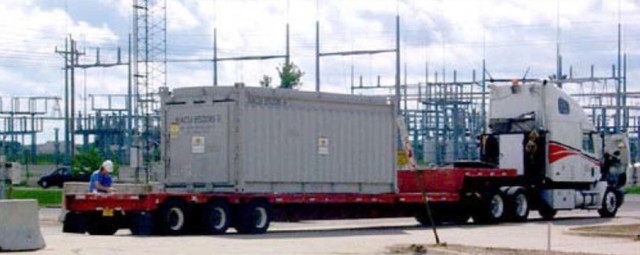Nevada to have stronger voice in nuke waste burial
WASHINGTON — Gov. Brian Sandoval and the federal government announced Tuesday they have reached an agreement giving the state a stronger voice over radioactive waste shipped into Nevada and buried in a landfill at the government’s national security site in Nye County.
The deal stems from the impasse over the disposal of 403 canisters of potent uranium-233 commingled with uranium-235, atom-splitting material containing byproducts that can be used to make a bomb. The standoff has stalled a cleanup at the Oak Ridge National Laboratory in Tennessee, where the material had been stored for decades in an aging warehouse.
Capping more than a year of talks triggered by growing public concern in Nevada, Sandoval and Energy Secretary Ernest Moniz signed a six-page memorandum Monday spelling out a new relationship in dealing with radioactive material transported and disposed of in the Area 5 landfill of the Nevada National Security Site.
Contrary to an early Review-Journal report, state officials emphasized the agreement does not finalize a path for the uranium waste still on hold at Oak Ridge. Those talks are ongoing and the waste remains in Tennessee, state and federal officials said.
Rather, as the government continues to clean up radioactive material from Cold War-era nuclear weapons factories and storage sites, the agreement promises further consultations with Nevada officials over potentially exotic waste forms that might stretch the definition of “low level” contaminated debris buried at the sprawling desert reservation 45 miles north of Pahrump.
“This is an important step forward in ensuring continuity in collaboration between Nevada and the Department of Energy,” Sandoval said in a statement. “Today’s announcement solidifies the Nevada National Security Site Working Group and represents a milestone achievement in our commitment to candid and direct communication on these critical issues.”
Reflecting the ongoing negotiations, the memorandum calls for the uranium shipments to travel in secret accompanied by high-level security and for the waste to be further isolated at burial to protect against theft or sabotage. DOE in the past year held four “tabletop” exercises with state emergency responders from Nye and Clark counties, and promised to cooperate with them “in the highly unlikely event of an accident.”
Nevada and the Department of Energy waged a long war over disposing high-level nuclear waste at Yucca Mountain. But it was unusual for them to be at odds over operations at the Nevada National Security Site, formerly known as the Nevada Test Site where the state long supported government-detonated atomic bomb tests and where the National Nuclear Security Administration still conducts nuclear weapons experiments.
Moniz in a statement said the agreement preserves a “productive relationship” between the state and the Department of Energy.
“I am aware of what is taking place — this agreement was with Gov. Sandoval and Secretary Moniz — and am pleased it seems they were able to work something out,” Sen. Harry Reid, D-Nev., said in a statement issued by his office.
State officials had grown concerned that the proposed uranium waste shipments might open the door for other exotic forms of nuclear waste. The worries grew after DOE in May 2013 appeared to broaden its “waste acceptance” guidelines for the types of material that might be buried at the Nevada site.
As part of the agreement signed Monday, DOE is retracting some of the changes to its waste acceptance criteria. The department said it also identified two other waste streams once destined for Nevada that now will be shipped to other landfills. Officials could provide no immediate details on those forms of waste and their destinations.
Sandoval and Moniz also agreed that a group of senior-level state and federal officials will continue to meet at least twice a year on waste issues and to discuss possible new missions at the 1,351 square mile Nevada National Security Site.
The group would be charged with reviewing proposed changes to the waste acceptance guidelines of what could be buried at the Area 5 landfill. The agreement also calls for an independent scientific body to review how the Department of Energy classifies low-level waste for purposes of disposal.
For instance, while the Oak Ridge waste was classified as “low level,” it would be as much as 1,500 times more radioactive than contaminated debris usually buried at the Area 5 landfill. The waste canisters require heavy shielding and will need to be handled by remote-control cranes.
“Since this issue first came to light, I’ve stressed the need for transparency and open communication from DOE,” said Rep. Dina Titus, D-Nev. “I am hopeful this formalization of the working group addresses the community’s concerns when it comes to this waste, and any waste being transported through our state.”
Judy Treichel, head of the Nevada Nuclear Waste Task Force, said the agreement may bring some order to how the government classifies various forms of nuclear waste for disposal.
“There may be through this formalized working group finally some sort of sensible waste classification,” Treichel said. “That has always been insane. You can get low-level waste that is really, really dangerous just because it does not fit into another category but is more radioactive and dangerous than some of the stuff that is classified as high level.”
North Las Vegas Mayor John Lee, who has strongly criticized the move to transport the waste through the valley, welcomed the announcement Tuesday.
“It is good to hear the federal government is starting to listen to our concerns in Southern Nevada, and I will do all I can to prevent dangerous material from being transported through the community I am sworn to protect,” he said in a prepared remark. Lee is the local politician who exclaimed in late November, “If it’s going through North Las Vegas, I will block the freeways.”

















